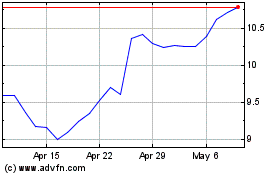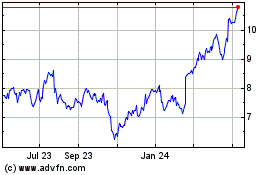U.S. Government Bond Selloff Resumes
November 24 2016 - 2:20AM
Dow Jones News
A brightening economic outlook is weighing heavily on U.S.
government bonds, and the prospect of looser fiscal policy under
Donald Trump isn't the only factor behind the optimism.
Bond markets were hit by a fresh wave of selling Wednesday after
the Commerce Department said orders for durable goods rose 4.8% in
October from a month earlier, the fastest pace in a year and well
above the 2.7% gain predicted by economists surveyed by The Wall
Street Journal.
Bonds have sold off sharply since Donald Trump's victory in the
Nov. 8 presidential election, as investors respond to the increased
chances of fiscal stimulus next year.
Investors have calculated that large tax cuts and increased
infrastructure spending could boost growth and inflation as well as
increase the supply of government bonds, all of which would erode
the value of existing government debt.
Though some have questioned whether the severity of the selloff
has been warranted given the unpredictable nature of government
policy, a solid run of economic data has helped support the
move.
In addition to the durable goods report, recent data highlights
include the best two-month stretch of retail sales in at least two
years, the fastest monthly pace of housing starts since 2007 and
better-than-expected monthly wage growth for workers.
If the bond market has already priced in an interest-rate
increase by the Federal Reserve in December, economic data still
matters for the "pricing in of next year's hikes," said Priya
Misra, head of global rates strategy at TD Securities in New
York.
Recent data is a "good sign, because you're already running at
close to potential GDP" so the potential for fiscal stimulus just
creates "more room for upside," she said.
The yield on the benchmark 10-year Treasury note settled
Wednesday at 2.355%, up from 2.319% Tuesday and 1.867% on Election
Day.
Yields on European government bonds also moved higher. The
10-year German bund yield rose to 0.259% from 0.231% Tuesday, while
the 10-year U.K. bond yield climbed to 1.451% from 1.391%,
according to Tradeweb.
Yields rise when bond prices fall.
As expected, minutes from the Fed's Nov. 1-2 meeting released
Wednesday showed officials believed an interest-rate increase was
possible "relatively soon" barring a change in the economic
outlook.
Wednesday's selling was felt across the Treasury yield curve,
with yields on shorter-term and longer-term bonds all rising. The
yield on the 30-year bond, which is especially sensitive to changes
in inflation expectations, reached 3.089%, its highest intraday
level since early Dec. 2015, before sliding back down to
3.022%.
The 30-year bond yield has closed above 3% for four consecutive
days, the longest streak since it Nov. 2015, when it remained above
that threshold for 13 days.
There were some indications Wednesday of higher bond yields
starting to bring back buyers. Bonds were under intense pressure
early in the day ahead of a $28 billion sale of seven-year Treasury
notes. But prices ticked up after the auction, which drew strong
interest from indirect bidders in particular, hinting at demand
from overseas.
Before the release of the durable goods report, government bonds
had already sold off in Europe amid speculation that the European
Central Bank could lend out more of its large stockpile of
government bonds in an effort to provide more collateral for
short-term lending among financial institutions.
Such a move wouldn't mean that the central bank would have to
scale back its current bond-buying program, which expires in March
and should be reviewed at the ECB's December policy meeting. But
its prospect adds to investors' concerns that a larger volume of
European bonds could end up in circulation. If executed, it could
also make it easier for traders to short government debt, analysts
said.
While bond yields remain low by historical standards, their
sharp recent rise has inflected pain on investors.
The Treasury bond market has posted a negative 2.52% return --
including bond price gains and interest payments -- this month
through Tuesday, according to data from Bloomberg Barclays U.S.
Treasury index. For the year, the index has still logged a 1.3%
return.
Write to Sam Goldfarb at sam.goldfarb@wsj.com
(END) Dow Jones Newswires
November 24, 2016 02:05 ET (07:05 GMT)
Copyright (c) 2016 Dow Jones & Company, Inc.
Barclays (NYSE:BCS)
Historical Stock Chart
From Aug 2024 to Sep 2024

Barclays (NYSE:BCS)
Historical Stock Chart
From Sep 2023 to Sep 2024
